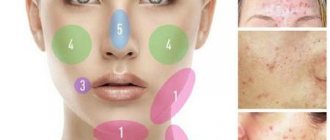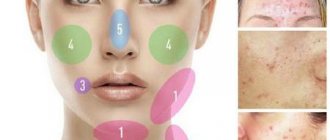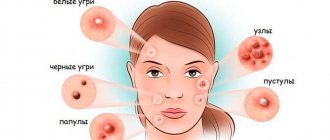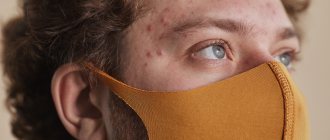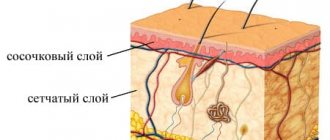Acne occurs in 40-45% of girls during puberty. At the age of 23-25 years, this figure decreases by half, and after 30 years, no more than 5% of women suffer from acne. In adolescence, the dermatological problem is caused mainly by hormonal changes. The causes of acne on the face of a 30-year-old woman lie in pathologies of internal organs, the negative influence of external or internal factors. The success of acne therapy depends on the accuracy of the diagnosis. Therefore, when acne appears after 25-30 years, consult a dermatologist.
Pimples* on the face: causes of occurrence in women104
Women's health and skin condition largely depend on hormonal levels. The male hormone testosterone is responsible for the processes that occur in the epidermis. In women, it is produced by the adrenal glands and ovaries.
With increased secretion of androgens, the sebaceous glands begin to produce too much sebum. Gradually it mixes with particles of dirt, dead cells, cosmetics and undergoes oxidation under the influence of oxygen. This is how open comedones are formed.
Hypersensitivity to steroid hormones in women over 30 years of age is one of the main causes of acne. An increase in androgen activity disrupts the water-lipid balance and causes clogged pores. Gradually, against the background of a slowdown in the process of sebum removal, bacteria begin to multiply in the sebaceous glands, and foci of inflammation appear on the skin.
An active increase in the level of androgens and the tendency to form acne is especially pronounced in the second phase of the menstrual cycle. Before the onset of menstruation, the level of steroid hormones in the body sharply increases, which activate comedogenic processes.
Skin problems after thirty manifest themselves in different ways:
- The first deep wrinkles. Subtle lines around the eyes begin to turn into full-fledged crow's feet, and horizontal wrinkles on the forehead become noticeable.
- Acne after 30 years in women. Some people experience late acne, while others experience another exacerbation of the disease.
- Hyperpigmentation. We can talk about both age-related changes and photodamage.
- The skin becomes dry, dull, and in the T-zone, on the contrary, acquires an oily sheen.
Hormones are one of the main factors causing these problems, especially in women. Most hormonal changes begin around age 30. In addition, accumulated problems with the gastrointestinal tract, the consequences of poor nutrition, gravitational ptosis, active facial expressions and photoaging affect the appearance of the skin.
Saving the T-zone in a cosmetologist's office
When caring for the T-zone, you need to take into account that oily skin in this area may be normal or even prone to dryness in other areas. Therefore, the choice of cosmetic procedures for mixed skin types requires an individual approach. Cosmetologists can recommend the following techniques.
Cleaning (hardware, ultrasonic)
Regular implementation of such procedures enhances the outflow of the contents of the sebaceous glands, ensuring the prevention of inflammation. This avoids the appearance of comedones and pigmentation.
If acne* occurs in women at the age of 30, the causes may be related to stress, poor diet, and hormonal imbalances. Their identification is paramount, and only after that should therapy be carried out. During acne exacerbation, cleaning should not be carried out.
Glycolic peeling
It has a complex effect, firstly, enhancing the exfoliation of dead cells of the stratum corneum, and secondly, normalizing the function of the sebaceous glands. After 6-8 procedures (twice a year), the epidermis thickens, regeneration increases, wrinkles are smoothed out and as a result the face has a healthier, younger, fresher appearance.
Mesotherapy
Cocktails individually selected taking into account the needs of the skin improve blood supply to tissues and ensure normal metabolism in cells. Mesococktails may contain:
- hyaluronic acid;
- vitamins A, B, E, C;
- inhibitors of oxidative processes (copper, silicon, magnesium, zinc, manganese);
- antioxidants;
- glycolic acid;
- panthenol.
Phototherapy
A hardware procedure that not only cleanses and tightens pores, but also fights post-acne, pigmentation and bacteria inside the sebaceous glands.
In a cosmetologist's office, you can be offered professional care with an emphasis on the T-zone, including creams, gels, masks, scrubs, serums, as well as hardware techniques.
To achieve long-lasting anti-aging results, I use fillers based on hyaluronic acid and preparations containing botulinum toxin. The former fight against eyebrow wrinkles and ptosis, and the latter with facial overexpression.
If the goal is to fight acne, it is recommended to first visit a dermatologist.
Why do women get acne* on their faces? 104
In adult women, acne is often associated with hormonal diseases of the reproductive system (mastopathy, polycystic ovary syndrome, fibroids, etc.). In some cases, acne is the first indication of the presence of hyperandrogenism. If you have acne on your face, it is important to determine the true reasons for its formation. The fact is that every disease that causes rashes requires specialized, often complex, treatment.
In modern medicine and cosmetology, a number of hormonal factors are identified that lead to the formation of late acne in women:
- Changes in hormonal levels before menstruation. An increase in progesterone levels activates the secretion of sebum, which in turn provokes the formation of premenstrual acne.
- Reception OK. Oral contraceptives contain substances that change the course of the natural processes of hormone production in the female body. In some cases, during use or at the stage of discontinuation of OCs, sebum production is activated, which leads to the formation of acne.
- Endocrine diseases. Dysfunction of the adrenal cortex, pathologies of the pituitary gland and other pathologies of the endocrine system cause excessive acne formation in some women.
- Gynecological diseases. Pathologies of the reproductive system are often a provoking factor in the development of acne in women. In particular, in many patients aged 30-40 years, the appearance of acne is associated with polycystic ovary syndrome.
- Pregnancy. During pregnancy, a woman's body undergoes active hormonal changes, so the appearance of acne during this period is absolutely normal. Especially in the first trimester.
- Menopausal syndrome. Usually observed during the decline of childbearing functions. It is caused by a gradual decrease in the size of the ovaries and uterus, the disappearance of menstrual bleeding. Hormonal changes that occur in the body during menopause often provoke excessive sebum secretion and, as a result, acne.
Stress and anxiety
Many people notice that pimples appear when they are depressed or after stress. Due to worries, the work of the sebaceous glands increases, the skin becomes oily, and this favors the appearance of skin rashes. Neurosis causes the release of adrenaline, norepinephrine and other male hormones, causing the sebaceous glands to work actively. With depression, acne develops and grows, the skin changes its structure at 27-30 years old, so any violations take much longer to pass and leave behind scars. It is recommended to avoid stress.
You need to awaken a positive state in yourself to stop the production of sebaceous glands. You need to be able to relax. Soothing baths and watching good films will help with this. Only after you have calmed down can you begin treatment so that inflammation disappears and new ones do not appear. Try to quickly get out of an anxious state to stop further production of unnecessary hormones.
What to do if acne occurs?
To get rid of acne, you must first determine the true causes of the pathology. Before performing cosmetic procedures, experts advise visiting a dermatologist, endocrinologist, gastroenterologist and, of course, a gynecologist. Treatment of acne caused by gynecological or endocrine diseases includes eliminating the primary causes of the rash.
To help the body cope with acne faster, cosmetologists recommend reviewing your diet. Changing gastronomic habits (giving up sweets, flour, spicy, salty, etc.) can have a positive effect on the condition of the face.
What do pimples indicate?
The skin is not just a protective case, but also a kind of “scanner” that shows how healthy the body is. The localization of acne indicates internal diseases. The rash appears on the face, neck, back, buttocks and chest. Some rashes indicate a disruption in the functioning of certain organs.
- pimples at 30 years old signal erosion of the cervix and disruption of the ovaries;
- rashes on the cheeks, wings of the nose and forehead indicate diseases of the stomach, kidneys, and liver;
- acne indicates a decrease in immunity;
- avitaminosis;
- rashes on the neck indicate problems in the genitourinary system;
- pimples on the chin indicate diseases of the lymphatic system and genital organs;
- any rashes indicate slagging in the body.
In these cases, it is necessary to switch to a healthy lifestyle and start monitoring your condition.
Acne on the face: causes and treatment
There are many reasons for the occurrence of acne: the use of cosmetics with comedogenic ingredients, stress, genetic predisposition, taking medications (for example, anabolic steroids), gastrointestinal pathologies, etc.31,49,80. When prescribing treatment, the dermatologist also takes into account why the rash appeared. In the treatment of mild to moderate acne, azelaic acid, for example, Azelik®5,9, can be used. The drug is used twice a day5. It is applied to clean, dry skin5.
*acne
Acne treatment
There are many reasons leading to the development of the disease. Treatment methods directly depend on the location and extent of the rash.
- a small acne located in the forehead and nose area;
- acne turning into a purulent stage;
- widely distributed throughout the body - face, back, chest;
- acne deepens, the rashes merge with each other, forming large nodes.
Mild stages can be treated at home. You should eat right, cleanse your body, and don’t forget about cosmetic procedures and folk remedies. Turpentine baths help a lot. It is worth playing sports to activate your metabolism.
Cosmetic procedures
Grandmothers knew a great way to prolong beauty and youth - a bath. The steam room is an excellent way to cleanse, when the skin is steamed and all excess comes out through the pores. This procedure actively stimulates blood circulation and rejuvenates the skin. You can make a steam bath at home for your face: brew coltsfoot, birch, lemon balm in water and hold your face over the pan for 20 minutes, cover your head with a towel. After this procedure, you should apply a nourishing mask.
- Mix 3 tbsp. cinnamon and 4 tbsp. honey Keep on face for 20-30 minutes. The procedure helps remove inflammation.
- 1 pinch of white clay, 3 tsp. mix honey, olive oil and leave on face for 20-25 minutes. The mask dries out acne.
- Mix cottage cheese 2 tbsp. with oat decoction 1 tbsp. Apply to face for 20-25 minutes.
A natural face wash helps a lot: add 100 g of oatmeal and water to a 3-liter jar, strain in the morning, and wash your face daily. Store the product in the refrigerator.
Therapeutic diet
Normalization of metabolism will immediately affect the skin of the face. When the body is cleansed, the skin becomes clean and radiant. If necessary, you need to follow a diet.
- for breakfast, buckwheat porridge, with prunes or raisins;
- for lunch, buckwheat baked with lean chicken;
- for dinner, buckwheat with baked cauliflower, green beans or a mix of vegetables.
Drink low-fat kefir, green tea, the diet is designed for long-term use (for) a month. With this diet, carbohydrates are balanced, a small amount of fat enters the body, and the food is rich in dietary fiber.
- breakfast - salad with apples, cabbage, carrots or fruits;
- lunch - lean vegetable soup, boiled meat;
- dinner - vegetable casserole and an apple in any form.
READ ALSO: Prolactin is elevated, acne on the back and chest has been bothering me for a year - Question to the endocrinologist - 03 Online
Drink compotes. Maintain this diet for 5-6 days. The diet will improve your well-being and not only cleanse the body, but also boost your immunity by consuming large amounts of vitamin C. You should cleanse once a month to normalize your metabolism and maintain it (fasting day on kefir). Additionally, you can fast for 24 hours once a year. With any diet you need to take vitamin complexes and monitor your well-being.

